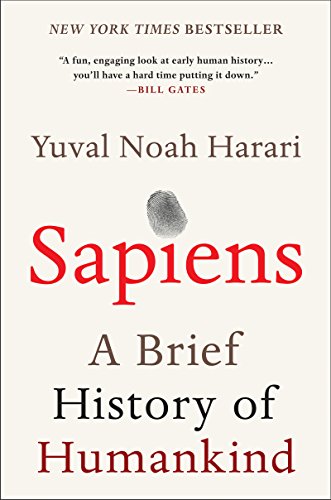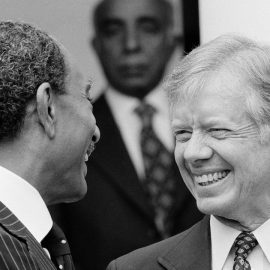

This article is an excerpt from the Shortform summary of "Sapiens: A Brief History of Humankind" by Yuval Noah Harari. Shortform has the world's best summaries of books you should be reading.
Like this article? Sign up for a free trial here .
How did our current global empire form? What factors unified disparate cultures, and how were money and empires involved?
We’ll cover how the monetary order and imperialism, though they came with many disadvantages, shaped our world into the global empire that it is today. Money and empire were ultimately unifying forces.
Money: Creating a Global Empire
The first unifier of humankind into a global empire is money.
Money brought cultures that had little in common together. This would eventually form a global empire. The gold coins used from Rome to India were close enough to the coins used in China that all these areas developed commercial and monetary relations. The whole world became a single monetary zone by the late modern era, leading to the creation of a single global financial and political community. Even if they didn’t speak the same language or believe in the same god, people from every corner of the globe shared the imagined belief in the value of silver and gold.
Why did they share this belief? How did they all come to believe in the same currencies when previously, some believed in cowry shells, some in barley, some in cloth, and some in beads. How did the currency become unified, the system of mutual trust in gold spreading across the globe?
It has to do with supply and demand. To understand this, let’s look at a hypothetical example. Let’s say that India and the Mediterranean start trading with each other. Indians don’t value gold. To them, it’s a relatively useless metal. It’s worthless. But in the Mediterranean, gold is a status symbol, used in jewelry and crowns to highlight the wearer’s prestige. In the Mediterranean, gold is extremely valuable.
So what happens? When trading, Mediterranean merchants notice that they can get gold for next to nothing in India, where it’s worthless. So they trade their goods for a lot of gold in India and sell the gold at a high price back in the Mediterranean. As the demand for Indian gold increases, and Indians see how badly the Mediterraneans want it, the value of gold in India goes up. Meanwhile, the Mediterranean is flooded with gold and its value drops.
With the value of gold rising in India and dropping in the Mediterranean, gold’s value in both places equalizes. Additionally, because the Mediterraneans believe in the value of gold, the Indians start to believe in its value, too. They value it because the Mediterranean merchants want it. The Indians want gold so they can trade it for what it is they actually want.
In this way, money encourages unity far more easily than religion because “whereas religion asks us to believe in something, money asks us to believe that other people believe in something.” This is much easier, and it contributed to the creation of a global empire.
Empires: Creating a Global Empire
Money has brought the disparate worlds on Earth into one global empire, but the market doesn’t always win. We can’t view human history solely through the lens of economy. While gold and silver had a huge impact in shaping our world, steel did as well.
The second unifier of humankind into a global empire is empire.
The Dissolution of Us versus Them
Imperialism began to dissolve cultural divides in two ways:
Way #1: After hundreds of years, the conquered people had so assimilated that there was no trace left of their original culture.
For example, by the time the Roman Empire fell in 476 AD, it had absorbed the Numantians, Samnites, Umbrians, and Etruscans, among other groups. These groups didn’t gain independence with the end of Roman rule because they no longer existed. Everyone who could trace their ancestry back to these groups now spoke Latin, worshipped Roman gods, and lived just as their fellow Romans did. They were Roman now, not Umbrian or Etruscan.
Way #2: Because of their inclusivity and tolerance of conquered cultures, rulers often adopted and spread norms, beliefs, and traditions from the people they conquered.
In this way, empires became hybrids of the civilizations they conquered. For example, imperial Roman culture “was Greek almost as much as Roman,” and the Abbasid culture was a hybrid of Greek, Arab, and Persian cultures.
Although tolerance and dissolving antagonism are good things, the process often eradicated local cultures or altered them beyond recognition, and it was often difficult for conquered subjects to adapt to the hybrid culture.
The erasure of individual cultures would make a single, global empire.
The Future: A Global Empire
As the world gets smaller and smaller, we’re moving toward a single global empire. We’re becoming decreasingly nationalistic, and governments have become more and more interested in protecting human rights around the world rather than just in their own countries.
Today, countries can’t function independently. The actions and values of other countries affect our economic policies, our social policies, and our ability to wage wars. We’re affected by global markets, international human rights organizations, and NGOs. International issues such as global warming are increasing the need for a unified global community. No one country can function on its own.
———End of Preview———

Like what you just read? Read the rest of the world's best summary of "Sapiens" at Shortform . Learn the book's critical concepts in 20 minutes or less .
Here's what you'll find in our full Sapiens summary :
- How Sapiens outlived and outlasted the 8+ other human-like species on Earth
- The 3 critical revolutions in human existence that led to our domination of the planet
- How much of what powers our world today is really just a shared mass delusion
- What the future of humanity might look like






